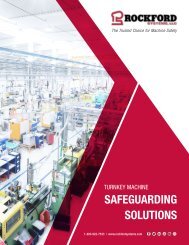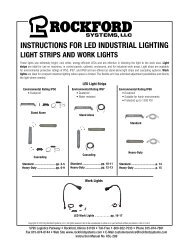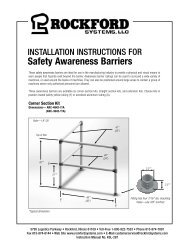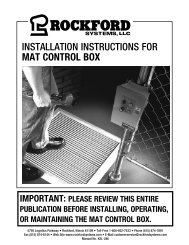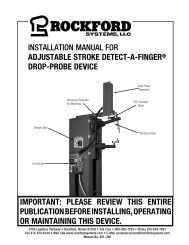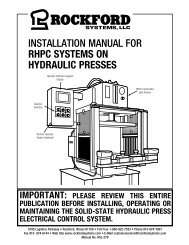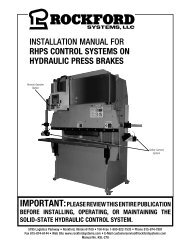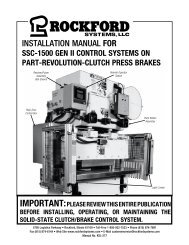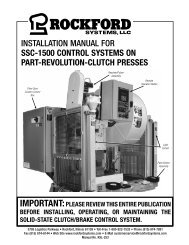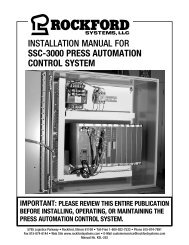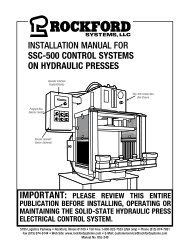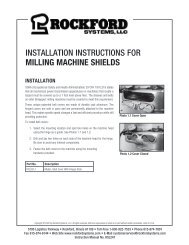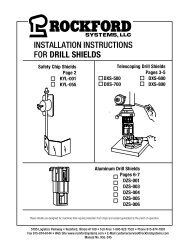Rockford Systems Shields for Safeguarding Machines Catalog
FREE, comprehensive 80-page catalog that features a complete line of equipment to protect operators of cutting and turning machines. These products comply with OSHA and ANSI standards. The polycarbonate and steel shields found in this catalog can be applied to drill presses, lathes, milling machines, bench grinders, band saws, and disc and belt sanders. The catalog also offers emergency-stop devices, disconnect switches, magnetic motor starters, lockouts, and danger signs.
FREE, comprehensive 80-page catalog that features a complete line of equipment to protect operators of cutting and turning machines. These products comply with OSHA and ANSI standards. The polycarbonate and steel shields found in this catalog can be applied to drill presses, lathes, milling machines, bench grinders, band saws, and disc and belt sanders. The catalog also offers emergency-stop devices, disconnect switches, magnetic motor starters, lockouts, and danger signs.
- No tags were found...
You also want an ePaper? Increase the reach of your titles
YUMPU automatically turns print PDFs into web optimized ePapers that Google loves.
INTRODUCTION<br />
INTRODUCTION (CONTINUED)<br />
DEVICES FOR STOP AND EMERGENCY STOP<br />
In accordance with 10.7.1.1, “Stop and emergency stop pushbuttons<br />
shall be continuously operable and readily accessible.” According to<br />
10.7.1.2, “Stop or emergency stop pushbuttons shall be located at each<br />
operator control station and at other locations where emergency stop is<br />
required.”<br />
In 10.7.2.1, it states that “The types of devices <strong>for</strong> emergency stop shall<br />
include, but are not limited to, the following:<br />
(1) Pushbutton-operated switches<br />
(2) Pull-cord-operated switches<br />
(3) Foot-operated switches without a mechanical guard<br />
(4) Push-bar-operated switches<br />
(5) Rod-operated switches”<br />
According to 10.7.2.2, “Pushbutton-type devices <strong>for</strong> emergency stop<br />
shall be of the self-latching type and shall have direct opening<br />
operation.” In accordance with 10.7.2.3, “Emergency stop switches<br />
shall not be flat switches or graphic representations based on software<br />
applications.” For restoration of normal function after emergency<br />
switching off, 10.8.3 says that “It shall not be possible to restore an<br />
emergency switching off circuit until the emergency switching off circuit<br />
has been manually reset.” According to 10.7.3, “Actuators of emergency<br />
stop devices shall be colored RED. The background immediately around<br />
pushbuttons and disconnect switch actuators used as emergency stop<br />
devices shall be colored YELLOW. The actuator of a pushbutton-operated<br />
device shall be of the palm or mushroom-head type and shall effect an<br />
emergency stop when depressed. The RED/YELLOW color combination<br />
shall be reserved exclusively <strong>for</strong> emergency stop applications. Exception:<br />
The RED/YELLOW color combination shall be permitted <strong>for</strong> emergency<br />
stop actuators in accordance with 10.8.4.”<br />
Under 10.8.5, “Where the supply disconnecting means is to be locally<br />
operated <strong>for</strong> emergency switching off, it shall be readily accessible and<br />
shall meet the color requirements of 10.8.4.1.” According to 10.8.4.1,<br />
“Actuators of emergency switching off devices shall be colored RED. The<br />
background immediately around the device actuator shall be permitted<br />
to be colored YELLOW.”<br />
PUSHBUTTON ACTUATORS<br />
According to 10.2.1, “Pushbutton actuators used to initiate a stop<br />
function shall be of the extended operator or mushroom-head type.” As<br />
stated in 10.2.2.1, “The preferred color of start or on shall be GREEN,<br />
except that BLACK, WHITE, or GRAY shall be permitted. RED shall not<br />
be used <strong>for</strong> start or on.” In 10.2.2.2, it states that “the preferred color<br />
<strong>for</strong> stop or off shall be RED, except that BLACK, WHITE, or GRAY shall<br />
be permitted. GREEN shall not be used <strong>for</strong> stop or off.” According<br />
to 10.2.2.6, “Pushbuttons that cause movement when pressed and<br />
stop movement when they are released (e.g., jogging) shall be BLACK,<br />
WHITE, GRAY, or BLUE, with a preference <strong>for</strong> BLACK.” In accordance with<br />
10.2.3.1, “A legend shall be provided <strong>for</strong> each operator interface device<br />
to identify its function and shall be located so that it can be easily read<br />
by the machine operator from the normal operator position. The legends<br />
shall be durable and suitable <strong>for</strong> the operating environment.”<br />
START DEVICES<br />
According to 10.6, “Actuators used to initiate a start function or the<br />
movement of machine elements (e.g., slides, spindles, carriers) shall be<br />
constructed and mounted to minimize inadvertent operation.”<br />
Protection Against Supply Interruption or Voltage Reduction and<br />
Subsequent Restoration<br />
Under 7.5.1, “Where a supply interruption or a voltage reduction can<br />
cause a hazardous condition or damage to the machine or to the work<br />
in progress, undervoltage protection shall be provided (e.g., to switch<br />
off the machine) at a predetermined voltage level.” For restarting, 7.5.3<br />
states that “Upon restoration of the voltage or upon switching on the<br />
incoming supply, automatic or unintentional restarting of the machine<br />
shall be prevented when such a restart causes a hazardous condition.”<br />
PROTECTIVE INTERLOCKS<br />
In 9.3.6, it states that “Where doors or guards have interlocked switches<br />
used in circuits with safety related functions, the interlocking devices<br />
shall be listed, have either positive (direct) opening operation, or provide<br />
similar reliability and prevent the operation of the equipment when the<br />
doors or guards are open (difficult to defeat or bypass).” Under 9.3.1,<br />
“The reclosing or resetting of an interlocking safeguard shall not initiate<br />
machine motion or operation that results in a hazardous condition.”<br />
OTHER SAFETY CONSIDERATIONS<br />
Each machine should be surveyed as an individual system. This includes,<br />
but is not limited to, the proper shield(s), controls, drives, tooling,<br />
feeding methods, material handling methods, configuration and weight<br />
of workpiece, rotating and reciprocating parts, machine production<br />
requirements, and future machine needs. The proper disconnect switch,<br />
motor starter, lockout equipment and covers <strong>for</strong> machine rotating<br />
components must also be considered. See pages 69 and 70 <strong>for</strong> a survey<br />
report.<br />
When operating the various machines to which shields can be applied,<br />
the operator must wear proper personal protective safety equipment and<br />
be properly trained. The operator must not wear loose clothing, have<br />
unrestrained long hair, and must not wear jewelry.<br />
When operating any cutting or turning machine, the<br />
hands or any part of a person’s body must never be put<br />
into the point of operation or any other hazard area of<br />
the machine. Hand tools, fixtures, and other methods<br />
must be used so that operators are not exposed to hazards. If<br />
the hands or any part of a person’s body is put into the hazard,<br />
it could cause serious physical injury or death.<br />
SAFETY SHIELDS | 9




